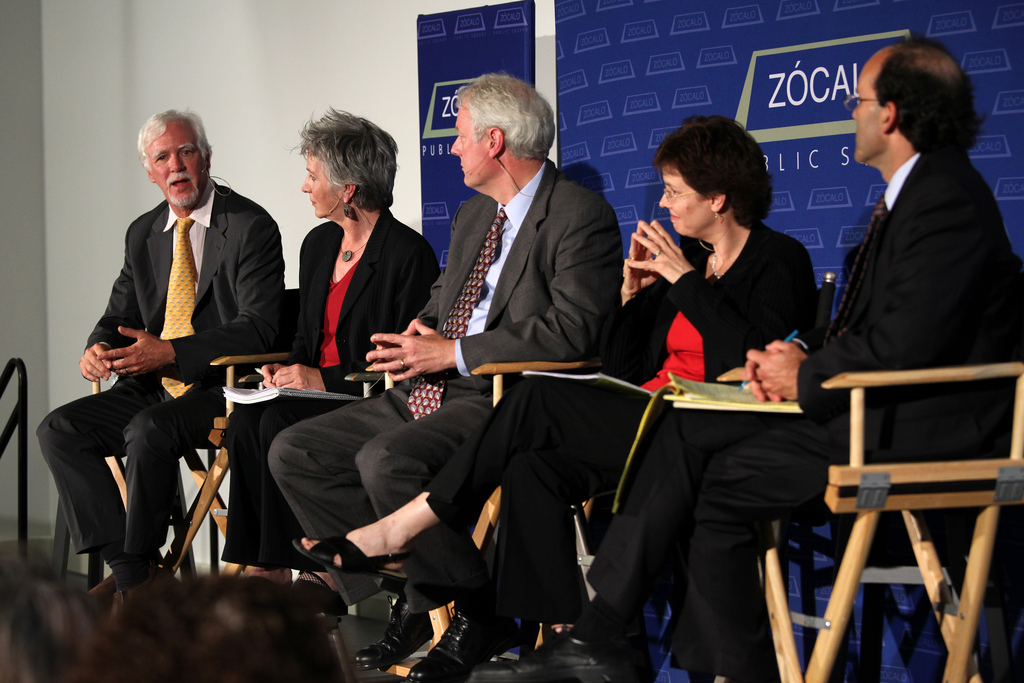
At 2,500 pages of legislation and even more pages of still unwritten regulation, health reform isn’t easy to comprehend.
But we can be sure of two things, as Duke Helfand, a Los Angeles Times health reporter, explained. “It has great potential to open access to care for millions of people,” he said. “But the criticism is it doesn’t do enough to tackle and address the underlying costs of that care.”
At an event made possible by the California HealthCare Foundation and moderated by Helfand, the California HealthCare Foundation’s Marian Mulkey, Jan Spencley of San Diegans for Healthcare Coverage, Small Business Majority Founder and CEO John Arensmeyer, and Lucien Wulsin of the Insure the Uninsured Project explained what the law does, what it means for Californians, businesses, doctors and insurers, and where it may fall short.
Work in progress
Despite its length, the law “is a work in progress,” Mulkey said. “There is a lot we still don’t know.” Many of the law’s major provisions won’t unfold until 2014, and the effect may not be felt until years later. The law will expand access to health insurance coverage, she said. First, it will expand Medicaid – which in California is called MediCal, a program that has historically served poor women, children, and the disabled. Under the new law, MediCal will cover anyone up to a particular level of income, “a big philosophical change,” Mulkey said. The law also significantly changes the private health insurance market: it requires that insurers sell to anyone willing to pay, and requires individuals to purchase health insurance, with subsidies up to a moderate income level, and with an easier reviewing, comparing and purchasing process, called an exchange. And though the law makes no mention of state-based single-payer systems, states are allowed to experiment starting in 2017 with their own systems, as long as they provide the same or a higher level of care.
 Other measures in the law aim to make healthcare more efficient – creating incentives for delivering preventive care and training physicians and other healthcare providers. “With more people covered, there’s more demand for services than, perhaps, our current workforce and our current arrangements can provide,” Mulkey said.
Other measures in the law aim to make healthcare more efficient – creating incentives for delivering preventive care and training physicians and other healthcare providers. “With more people covered, there’s more demand for services than, perhaps, our current workforce and our current arrangements can provide,” Mulkey said.
The law’s provisions won’t come at a low cost, she emphasized. Much of the money will come from changes in Medicare financing, making it possible to deliver care at lower cost. New fees on devices, the health insurance sector, and new taxes will fund the rest, along with penalties on employers and individuals who don’t comply.
Get in line early
The law’s provisions for the uninsured are particularly crucial for California, Wulsin explained. As of 2007, the state had 6.5 million uninsured people – nearly one in five of its population under 65, and one of the highest rates in the country. Eighty-five percent of those are working people, and 80 percent are citizens or legal permanent residents. The recession compounded the problem, and the latest estimates show that one in four Californians under 65 is uninsured.
Anyone without insurance currently has to pay out of pocket for any care outside a community hospital or clinic, and often the prices are three times as high as an insured person would pay. Many uninsured people wait until their health requires a visit to the emergency room – meaning higher rates of death, serious illness, and bankruptcy.
 So far, Wulsin explained, California is taking some steps to help its uninsured before the law’s provisions take hold in 2014. The state will receive $760 million to launch a new high-risk pool to cover about 30,000 people, beginning in September. (Californians can sign up at mrmib.ca.gov, though it’s still unclear what premiums will be, Mulkey noted in Q&A.) This will allow uninsured individuals to buy private insurance if they can afford it. “It’s good to get in that line early,” Wulsin said. Also effective this year, children will be able to get coverage regardless of preexisting conditions, and young adults will be allowed extended coverage on their parents’ plans. Finally, states and governments are negotiating a plan that would allow counties to double the money they currently spend on the uninsured, Wulsin said, which they’ll hopefully finish by September.
So far, Wulsin explained, California is taking some steps to help its uninsured before the law’s provisions take hold in 2014. The state will receive $760 million to launch a new high-risk pool to cover about 30,000 people, beginning in September. (Californians can sign up at mrmib.ca.gov, though it’s still unclear what premiums will be, Mulkey noted in Q&A.) This will allow uninsured individuals to buy private insurance if they can afford it. “It’s good to get in that line early,” Wulsin said. Also effective this year, children will be able to get coverage regardless of preexisting conditions, and young adults will be allowed extended coverage on their parents’ plans. Finally, states and governments are negotiating a plan that would allow counties to double the money they currently spend on the uninsured, Wulsin said, which they’ll hopefully finish by September.
Healthcare is local
The law also has important provisions for small businesses, Arensmeyer said. California alone has one million small businesses with employees, and three million self-employed people, “who have an even tougher time getting insurance, a huge impediment for people to start businesses,” he said. Right now, 86 percent of small businesses that don’t offer insurance cite cost as the factor; 72 percent that do offer insurance say they’re worried about being able to continue providing it. Without the health reform in place, small businesses would have to pay $2.4 trillion over the next 10 years, losing $1 billion in wages and much more in profits.
Starting this year, Arensmeyer said, health reform will offer tax credits for businesses with fewer than 25 employees, most with wages below $50,000, likely benefiting 80 percent of California’s small businesses. Big businesses over a certain size that don’t offer insurance will have to pay a fee, but that’s only about four percent of businesses, he said. The high-risk pool will help the self-employed immediately, as well. And, Arensmeyer said, the planned exchanges could be a major boon in the long term, eliminating the advantages bigger businesses have in negotiating for lower costs. Small businesses today pay 18 percent more than bigger ones for insurance, on average, he said, adding that the exchanges need to be governed well and explained clearly.
Localities play a crucial role in educating Californians about the law. “Healthcare is local,” Spencley said, and it may fall to local communities to explain who’s eligible for what care. “This isn’t a perfect bill. This is an incredible first step,” she said, noting that right now, Californians are paying not just in higher premiums and taxes. “We’re paying in people being left in poverty,” for people’s loss of productivity, for people waiting too long to get care.
Travelocity for health care
 Though the exchanges are three years away, they’ll transform how we receive health insurance. States have until 2014 to set up their own exchanges, with a variety of options: they can be statewide or regional, with varying levels of care provided, and varying levels of negotiation with insurance plans allowed. Spencley threw in her support for regional exchanges, given the vast size of California compared to other states. With bills passed by the state Senate and Assembly, he said, “California has started probably sooner than any state down this path.” And no matter the specifics, there will be more choice and more transparency, Arensmeyer said, as long as it’s a user-friendly process.
Though the exchanges are three years away, they’ll transform how we receive health insurance. States have until 2014 to set up their own exchanges, with a variety of options: they can be statewide or regional, with varying levels of care provided, and varying levels of negotiation with insurance plans allowed. Spencley threw in her support for regional exchanges, given the vast size of California compared to other states. With bills passed by the state Senate and Assembly, he said, “California has started probably sooner than any state down this path.” And no matter the specifics, there will be more choice and more transparency, Arensmeyer said, as long as it’s a user-friendly process.
The exchange could work something like Travelocity or Priceline, Wulsin said: “This will all happen, hopefully, in a very very simple web-based way.” But, he noted, there is only one operational exchange in this country, in Massachusetts. “The opportunities to mess this up are legion,” he said. “This is the best part of the bill, and the most challenging part.”
Primary care first
As Helfand noted, all the new coverage – no bans for patients with preexisting conditions, no annual or lifetime limits for payments – could mean a much bigger burden on doctors. Primary care physicians are in short supply, particularly in urban and many rural areas, Mulkey said. “There isn’t a short-term answer. The pipeline for doctors and nurses – it takes time. It doesn’t turn on a dime.” Some efforts are already under way thanks to the stimulus package, which included money for doctors to install new data systems or electronic medical care that can help people treat themselves when an office visit isn’t necessary. “There needs to be a lot of creative thinking from every corner of the health care system to take advantage of all the promise in the bill,” Mulkey said.
Spencley noted that nurses and physician’s assistants could pick up some of the burden. The National Health Service Corps also is likely to add 15,000 primary care physicians for underserved and low-income populations. “People are not selecting primary care as a specialty in medical school and there’s a reason for that,” she said. “They don’t get paid.” Wulsin agreed, noting that only about two percent of graduated medical students go into primary care, though the law does offer primary care reimbursements.
Hospitals, too, will have to become more efficient with their costs. “Price signals, the kind of things that drive all businesses to get better and better, to do things well for less – those have not been visible” for hospitals, Mulkey said, because they shift their costs to private insurers or Medicare and Medicaid. As Helfand noted, today, hospital costs and policies are so obscure that he interviewed a man who paid $44,000 for a knee surgery at one hospital, and $97,000 for the exact same procedure at another local hospital, even with the same surgeon.
Strange state
he Whether the law’s new provisions will drive premiums up or down is debatable, Wulsin said – preventive care could lower costs, getting rid of payment caps could push it up. The exchange could decrease prices, but it will increase the number of people covered, which would drive prices up. On average, Wulsin said, large employers will see a slight decrease, and small businesses could see either a slight increase or a slight decrease. Premiums have long risen faster than the economy, and in the short term, insurers and businesses reacting to short-term changes could cause premiums to go up. “There is an opportunity for things to get worse before they get better,” Mulkey said. Still, she noted, the costs will be going toward more comprehensive care.
Whether the law’s new provisions will drive premiums up or down is debatable, Wulsin said – preventive care could lower costs, getting rid of payment caps could push it up. The exchange could decrease prices, but it will increase the number of people covered, which would drive prices up. On average, Wulsin said, large employers will see a slight decrease, and small businesses could see either a slight increase or a slight decrease. Premiums have long risen faster than the economy, and in the short term, insurers and businesses reacting to short-term changes could cause premiums to go up. “There is an opportunity for things to get worse before they get better,” Mulkey said. Still, she noted, the costs will be going toward more comprehensive care.
Arensmeyer argued that the growth of costs isn’t going to come down in a big way until delivery reform and more robust cost containment mechanisms go into place. “All of us up here would’ve wanted more in the bill,” he said. “Negative cost containment means there is always some interest group who’s affected by that.”
As for those interest groups and the current gubernatorial election in California, the panelists were mum about who would do better on health. “Both candidates have been pretty quiet around any of the specifics,” Mulkey said. And the Insurance Commissioner, while powerful, oversees a smaller share of the insurance system than the overnor-appointed head of the Department of Health Management. As Helfand put it, “It’s a strange system we have in California.”
Watch the video here.
See more photos here.
Read In The Green Room Q&As with John Arensmeyer, Duke Helfand, Marian Mulkey, Jan Spencley, and Lucien Wulsin.
Read six health care experts on what the reform means for the state economy here.
*Photos by Aaron Salcido.




Send A Letter To the Editors